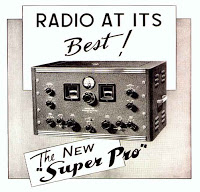George Ure and Gaye Levy, Contributors
Activist Post
Often times the two of us simply hang out during our weekly Skype conference call and just chat about whatever strikes our current curiosity bone. And you know, with so much communication being done these days via e-mail or social media, it is nice to hear a human voice and to partake in real human interaction.
Today we present the results of one of our recent chats with George (G1), the expert at all things radio and electronics, and Gaye (G2), who likes to think she is the expert at everything else but is just putting up a good front.
Gaye aka G2: One of George’s serious diseases, masquerading as a hobby, has been his just shy-of-50-year involvement with ham radio – that and over 45-years in broadcasting, starting from the engineering side.
As he has written many times:
Radio Disease: starts off innocently enough – perhaps with an innocent spin across the shortwave bands and hearing news from faraway places. Then it evolves to listening to what amateur radio operators (‘hams’) around the world are talking about. Next thing you know, there are classes at the local ham radio club, a short test (and no Morse Code requirements – that went away years ago) and then you’re off climbing the technical ladder.As you climb, the level of technical expertise increases, the complexity of radio gear increases, along with antennas and so on. Even so, for an investment of less than $600, a person can put together a wide-ranging home radio installation which will provide day or night communications around the world.
So, given my aforementioned curiosity, I decided to have George answer some questions which people frequently ask about shortwave communications (knowing full well that ham radio hobbyists are almost universally willing to share their expertise.)
George aka G1: Being able to monitor a wide range of radio (and companion satellite television and audio channels including network feeds) is extremely important to any person who wishes to become well-informed relative to what is going on in the world around them. So when I talk about the “magic of radio” we have to recognize that this is a very, very wide-ranging topic. Furthermore, the proper analysis of the magic is dependent upon what aspects of personal information you wish to focus on and manage.
Let’s start with the hobby side of radio.
Some people get into radio from the technical side. In my case, I started listening to tugboats on the Elliott Bay waterfront in Seattle with my clock radio when I was 12-years old. This was my entry point to communications as a hobby. But that was me. These days, most people don’t want to tear apart radios like I did back in the day. As a result, perhaps it is best if we come at the hobby from the standpoint of an urban dweller who has a job – or not – but who just knows there something more going on than is alluded to by their current collection of media inputs.
To begin with, a regular citizen of the U.S. may not realize the amount of social filtering which is applied by US-centric media. This is not to say it is specifically bad, or even deliberate. (Gaye’s note – yes it is!)
It’s just that someone who is an American in a foreign country will tend to report events around them – breaking news in particular – with and through the social filters implicit in coming from the highest income per capita and highest standard of living in the world. The eyes of an American and typically, a rich man’s eyes.
The problem distills down to the fact that the US media, being clock-driven and revenue reinforced, is very limited in the number (and depth) of news stories reported. So those that truly want to be informed, look for more. They turn to shortwave.
If you have never listened to shortwave radio, an easy way to sample what shortwave listening is like would be to listen to some of the already available in-depth news sources, like National Public Radio. When you do, you will find that what we’d call “long form” radio is much different than network “Sound Bite” news.
G2: So how does this relate to preppers, prepping, and leading the “strategic life”?
G1: Just this: A first stepping stone on the path to getting conscious control of your personal information platform is deliberately seeking out new sources of information that may/will challenge your current underlying (that is to say branded at the preconscious level) belief sets that control your expectations of how the world operates.
There was a dandy article in the Wall Street Journal recently which asks “So, What’s Your Algorithm? Since your brain is in essence an Input/Output processor, you know where this leads.
 So back to prepping. Before you start thinking about worst-case communications and buying equipment, you might consider whether you would use it if you had it during non-survival times.
So back to prepping. Before you start thinking about worst-case communications and buying equipment, you might consider whether you would use it if you had it during non-survival times.
Which is not to say that dependable short-range communication with ham and shortwave radio is about talking to strange people (and sizing up strange ideas) from faraway places. That is why I personally tend to watch foreign television news shows on Free to Air television – programming directly from China, Russia, Israel, Iran, and every other country that has some skin in the game we call “The Future.”
Side note: if this interest you, there is a great book I’ve mentioned before: “Build Your Own Free-to-Air (FTA) Satellite TV System” by Dennis C. Brewer. About $500 up front for the equipment, but after that, there are no monthly bills.
Like anything, there’s an investment/payback to be considered in shortwave and ham radio. If you can develop a taste for it, then you can spend some money on it and really enjoy it. On the other hand, if you only want the basics, such as a weather radio, an $82 dollar radio like the Grundig S350 will meet your needs for long-range, worst-case listening.
G2: That’s a load of theory, George, how about something more – you know – practical?
G1: You bet. One of the shows I have listened to on shortwave for years is one that is on weekdays and is broadcast on shortwave called “As It Happens”. It is done by the BBC. At one time it was only on a limited number of Canadian radio stations (and shortwave) but nowadays, thanks to the Internet, you can hear the program via the CBC website here.
This is a dandy example of the kind of quality you can stumble into on shortwave and then fold into your personal media blend.
G2: Okay then, if a person gets to the stage where they actually like NPR for in-depth news, and they have sampled some programs from a few foreign shortwave sites, what then?
G1: I always start any discussion of shortwave radio by recommending that you walk around your home with a portable AM radio which is tuned to the low end of the AM broadcast band. Don’t tune into a station. What you want to pick up is the general noise level around 550 to 600 on the AM radio dial.
The reason you need to do this is that you won’t want to pour a lot of money into a shortwave set, especially if you live in an electrically “noisy” environment. A good shortwave radio – like the Eton (Grundig) 750 which is about $265 at Amazon – will not be a good investment if you can’t hear anything due to noisy electrical appliances. Fine for camping trips or if the power goes out, though.
Using the cheap hand-held portable radio on the AM band, you should be able to hear which appliances generate radio noise. Light dimmer switches are notorious for wreaking havoc on both AM and shortwave bands. So before you invest in a good radio, you’ll want to sniff out – and resolve – those noise issues that you can. In most urban areas, you should be able to hear stations at the low end of the broadcast band pretty well, although the Big Radio Migration – from AM to FM which got underway in earnest in the early 1980s, has been bad for AM stations which have continued to decline in popularity.
One first “radio project” we might as well do is a fun “get your feet wet” exercise: Since most small portable AM/FM radios use a ferrite bar antenna inside for AM reception, you can use even that cheap little portable as your first real “direction-finder.” It’s really simple: hold the radio in a stable position while you’re standing in your yard while tuned in to a local AM station during the day. Generally, where the station reception is weakest is indicates the direction of the radio station.
A little practice with three or four local AM stations, if you have them, plus using Microsoft Streets & Trips and finding out where those AM station towers are, will quickly acclimate you to your new-found direction-finder.
Which sums up our first bit of radio learning: finding noise and the use of direction-finding capabilities. I know people who have made it to Hawaii on sailboats just using an AM radio and looking for clouds over islands which form in the afternoon in the tropics.
G2: What if I find a lot of noise?
G1: That gets to be difficult – depending on what the noise source is. If you go through the house and by turning off appliances you can’t find the noise source, you might try (after finishing this article!) turning off your computer gear. The reason is the power supplies in most computers are high-speed switching devices which can “back-feed” noise down the power cord. Anything that plugs in may be considered suspect until proven innocent.
G2: So if my “noise floor” is low, and I order a radio, what next?
G1: This is the easy part. If you’re ordering the radio from Amazon, also pick up a copy of WRTH – the World Radio Television Handbook. All kinds of interesting shortwave channels are listed there.
Then, if your computer is not wiping out the AM and Shortwave bands, you can hit online a site like Prime Time Shortwave.
 People often ask me “which radio?” and that’s a hard one to answer.
People often ask me “which radio?” and that’s a hard one to answer.
Yes, the CC Radios are good, as are the Grundigs. But consider your long-term interest in the hobby, too. It may not make too much sense to invest in a shortwave receiver-only, since if you’re committed to long-distance High Frequency ham radio operation, you need to save your money for an HF transceiver. Almost all the modern HF ham gear includes shortwave bands as part of their “general coverage” claims.
For general purposes, I’d recommend you buy a good NOAA Weather Radio, since in the event of a real disaster, official news and information is likely to be disseminated through this channel. The NOAA Weather radio is something that works almost everywhere and because it’s a narrow FM signal (which is more noise resistant) and because it’s a VHF (very high frequency) radio operating around 162-163 MHz. It is a must-have.
Another thing: leave it on all of the time with the alert feature set. This is especially a good idea if you live in areas subject to hurricanes or tornadoes.
G2: Why is it that some shortwave bands work during the day and different ones work at night?
G1: There are two kinds of radio propagation commonly used by consumers. Direct (or line of sight): This is how your cell phone works because it’s a UHF (ultra-high frequency) signal. Police and fire radios are also line-of-sight, too, since they typically operate in the 150-180 Megahertz (MHz) range, the 450-470 MHz range and a few are on what are called trunking systems up around 800 MHz.
FM radio, by the way is line-of-site and when your FM radio is scratchy-sounding it’s usually because you have a weak signal and a reflected (or bounced) signal is arriving at a slightly different time. That’s what causes ghosts in old-style television as well.
Ground Wave: AM radio is mainly ground wave. Low frequency signals come out from the station’s tower along the ground and tend to fill in shadow areas behind metal buildings, and such. But at night, the ionosphere starts to lower the frequency at which it will reflect signals back to earth. This is the “Sky Wave”. That is why at night you can often hear far away AM radio stations.
The same is true of shortwave. During the day the 19 meter band (15.1 to 15.8 MHz) range may bounce a signal from a station in Asia. But at night, as something called the Maximum Useable Frequency [MUF] drops, the 19-meter broadcasts stop reflecting and just goes off into space.
But while the distance on the 49-meter band may be limited to a few hundred miles during the day, when the MUF comes down at night, you can hear stations from all over the world between 5.9 and 6.2 MHz.
There’s also some seasonality to the MUF (and thus which bands work best) depending on how many hours of ionizing daylight there are. In the summer time, the higher bands (like the 19, 16, 15, and 13 meter bands) stay “open” (good for long distance listening) longer. In the winter, the lower bands rule and night time in the winter is when 120-meter listening is best, from 2.3 to 2.495 Mhz. The HAARP signals are just down a ways from there, by the way.
G2: Tell me again, George. Why would a person want to have a shortwave radio, practically speaking?
G1: If America ever had a really worst-case kind of event, like an electromagnetic pulse attack, a shortwave radio could get you news and information from halfway around the world. You would have the ability to know what is going on. That could be important if all official news and information sources have been destroyed or damaged.
The same thing would be true if there were massive power failures. As you know, this is not an altogether improbable event.
The other thing – and my favorite reason – is that to some folks, shortwave radio is just plain fun. It gives you a chance to brush up on your trend-spotting skills. New music, new politics, new ideas – they often show up first on obscure shortwave stations or satellite television channels.
G2: That’s probably enough to start thinking about for this week. This is somewhat technical and I need absorb what you have said. But promise me that next week we will get into more practical items like how to get the ham radio license, a discussion about antennas, and some of that radio jargon that can frankly sound pretty daunting.
G1: Okay Gaye. I promise not to make things difficult or daunting. And when it comes to that jargon, I will teach you about two dozen basic terms for your learning enjoyment. But, as we used to say in vocational education, the best way to learn is to get out and “do” something.
G2: Stayed tuned. Over and out (or whatever it is you are supposed to say in radio-speak)!
Hang on and enjoy the ride,
Introducing Strategic-Living: a practical and useful online magazine providing inspiration and guidance as we make our way through the maze of changes that are coming our way. In collaboration with my friend and colleague, George Ure, Strategic-Living will offer a synthesis of Urban Survival and Backdoor Survival with much more detailed tips, tools and strategies for creating a vibrant and sustainable lifestyle wherever your path may take you. Think of Urban Survival and Backdoor Survival as your roadmap and Strategic-Living as your detailed guidebook. Here you will find articles and photos, diagrams and how-to’s, and a healthy dose get-out-there and do it with kick-in-the-ass inspiration.
linkwithin_text=’Related Articles:’



Be the first to comment on "The Magic of Radio Part 1: Why Shortwave Radio Matters"